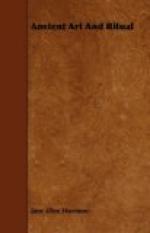* * * * *
At the back of our modern discontent there is lurking always this queer anomaly of the chorus. We have in our modern theatre no chorus, and when, in the opera, something of the nature of a chorus appears in the ballet, it is a chorus that really dances to amuse and excite us in the intervals of operatic action; it is not a chorus of doddering and pottering old men, moralizing on an action in which they are too feeble to join. Of course if we are classical scholars we do not cavil at the choral songs; the extreme difficulty of scanning and construing them alone commands a traditional respect; but if we are merely modern spectators, we may be respectful, we may even feel strangely excited, but we are certainly puzzled. The reason of our bewilderment is simple enough. These prologues and messengers’ speeches and ever-present choruses that trouble us are ritual forms still surviving at a time when the drama has fully developed out of the dromenon. We cannot here examine all these ritual forms in detail;[35] one, however, the chorus, strangest and most beautiful of all, it is essential we should understand.
Suppose that these choral songs have been put into English that in any way represents the beauty of the Greek; then certainly there will be some among the spectators who get a thrill from the chorus quite unknown to any modern stage effect, a feeling of emotion heightened yet restrained, a sense of entering into higher places, filled with a larger and a purer air—a sense of beauty born clean out of conflict and disaster.
A suspicion dawns upon the spectator that, great though the tragedies in themselves are, they owe their peculiar, their incommunicable beauty largely to this element of the chorus which seemed at first so strange.
Now by examining this chorus and understanding its function—nay, more, by considering the actual orchestra, the space on which the chorus danced, and the relation of that space to the rest of the theatre, to the stage and the place where the spectators sat—we shall get light at last on our main central problem: How did art arise out of ritual, and what is the relation of both to that actual life from which both art and ritual sprang?
* * * * *
The dramas of AEschylus certainly, and perhaps also those of Sophocles and Euripides, were played not upon the stage, and not in the theatre, but, strange though it sounds to us, in the orchestra. The theatre to the Greeks was simply “the place of seeing,” the place where the spectators sat; what they called the sk{-e}n{-e} or scene, was the tent or hut in which the actors dressed. But the kernel and centre of the whole was the orchestra, the circular dancing-place of the chorus; and, as the orchestra was the kernel and centre of the theatre, so the chorus, the band of dancing and singing men—this chorus that seems to us so odd and even superfluous—was the centre and kernel and starting-point of the drama. The chorus danced and sang that Dithyramb we know so well, and from the leaders of that Dithyramb we remember tragedy arose, and the chorus were at first, as an ancient writer tells us, just men and boys, tillers of the earth, who danced when they rested from sowing and ploughing.




